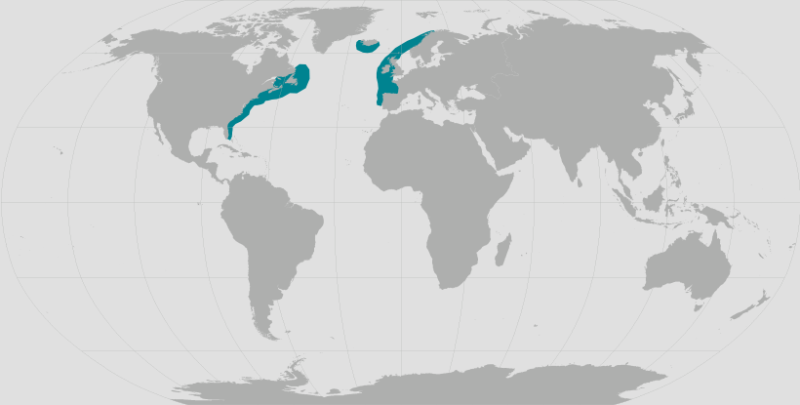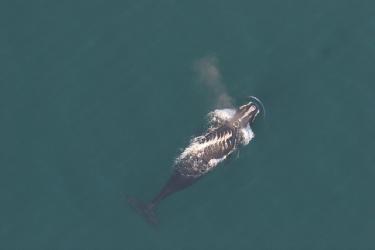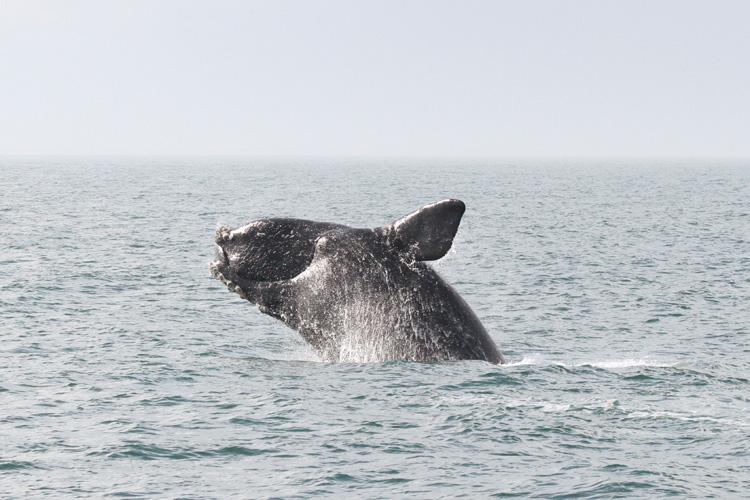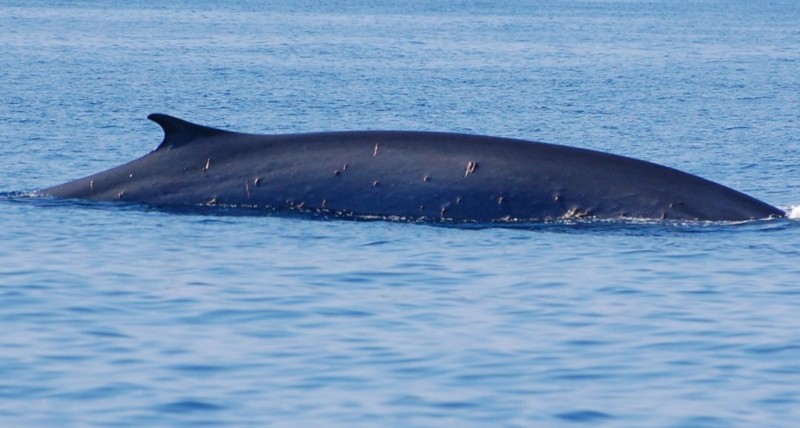About the Species
A right whale breaches. Credit: NOAA Fisheries
The North Atlantic right whale is one of the world’s most endangered large whale species.
Two other species of right whales exist: the North Pacific right whale, which is found in the North Pacific Ocean, and the Southern right whale, which is found in the southern hemisphere. Right whales are baleen whales, feeding on copepods (tiny crustaceans) by straining huge volumes of ocean water through their baleen plates, which act like a sieve.
By the early 1890s, commercial whalers had hunted North Atlantic right whales to the brink of extinction. (They got their name from being the « right » whales to hunt because they floated when they were killed.) Whaling is no longer a threat, but they have never recovered to pre-whaling numbers, and human interactions still present the greatest danger to this species. Entanglement in fishing gear and vessel strikes are the leading causes of North Atlantic right whale mortality. Increasing ocean noise levels from human activities are also a concern since the noise may interfere with right whale communication and increase their stress levels.
NOAA Fisheries and our partners are dedicated to conserving and rebuilding the North Atlantic right whale population. We use a variety of innovative techniques to study, protect, and recover these endangered whales. We engage our partners, including the fishing and shipping industries, as we develop regulations and management plans that foster healthy fisheries and reduce the risk of entanglements, slow down vessel traffic, and reduce ocean noise.
Read the North Atlantic Right Whale Scenario Planning Summary Report
Population Status
North Atlantic right whales have been listed as endangered under the Endangered Species Act since 1970. There are approximately 360 individuals remaining, including fewer than 70 reproductively active females. Human impacts continue to threaten the survival of this species. The number of new calves born in recent years has been below average.

They have experienced an ongoing Unusual Mortality Event since 2017, which includes sublethally injured or ill, seriously injured, and dead right whales. The whales impacted by the UME represent more than 20 percent of the population, which is a significant impact on an endangered species where deaths are outpacing births. Additionally, research demonstrates that only about 1/3 of right whale deaths are documented.
Appearance
North Atlantic right whales have stocky black bodies with no dorsal fins, and their blow spouts are shaped like a “V.” Their tails are broad, deeply notched, and all black with a smooth trailing edge. Their bellies may be all black or have irregularly shaped white patches. Pectoral flippers are relatively short, broad, and paddle-shaped. Calves are about 14 feet at birth and adults can grow to lengths of 52 feet.
Their heads have knobby white patches of rough skin, called callosities, which appear white because of whale lice (cyamids) covering their otherwise black skin. Each right whale has a unique pattern of callosities that scientists use to identify individual whales, an invaluable tool in tracking population size and health. Aerial and ship-based surveys and the North Atlantic Right Whale Consortium’s photo-identification database maintained by our partners at the New England Aquarium help track individuals over the years.
Behavior and Diet
When viewing right whales, you might see these enormous creatures breaching and then crashing back down with a thunderous splash. You might also see them swimming along with their rostrum out of the water as they skim feed on dense patches of plankton. Right whales feed by opening their mouths while swimming slowly through large patches of copepods and other zooplankton. They filter out these tiny organisms from the water through their baleen, where the copepods become trapped in a tangle of hair-like material that acts like a sieve. Right whales feed anywhere from the water’s surface to the bottom of the water column.
Groups of right whales may be seen actively socializing at the water’s surface, known as surface-active groups, or SAGs. Mating and socializing occurs in SAGs, which are observed during all seasons and in all habitats.
Right whales communicate using low-frequency moans, groans, and pulses, which may maintain contact between individuals, communicate threats, signal aggression, or be used for other social reasons.
Where They Live
North Atlantic right whales primarily occur in Atlantic coastal waters on the continental shelf, although they also are known to travel far offshore, over deep water.
Right whales migrate seasonally and may travel alone or in small groups. In the spring, summer, and into fall, many of these whales can be found in waters off New England and further north into Canadian waters, where they feed and mate.
Each fall, some right whales travel more than 1,000 miles from these feeding grounds to the shallow, coastal waters of their calving grounds off of South Carolina, Georgia, and northeastern Florida, though migration patterns vary.
NOAA Fisheries has designated two areas as critical habitat for North Atlantic right whales. These areas provide important feeding, nursery, and calving habitat:
- Off the coast of New England (foraging area)
- Off the southeast U.S. coast from Cape Fear, North Carolina, to below Cape Canaveral, Florida (calving area)

World map providing approximate representation of the North Atlantic right whale’s range.
Lifespan & Reproduction
Right whales can probably live for at least 70 years, but data on their average lifespan is limited since scientific monitoring of the species is fairly recent. Ear wax can be used to estimate age in right whales after they have died. Another way to determine lifespan is to look at groups of closely related species. There are indications that some species closely related to right whales may live more than 100 years. However, female North Atlantic right whales are now only living to around 45 years old and males only to around 65 years old. Such reduced lifespans are due to human-caused mortality, not old age.
In recent years, researchers have recorded more deaths among adult females than adult males, leading to a population with more males than females, a bias that is increasing over time. Females that undergo energetic stress from reproduction may be more susceptible than males to dying from chronic injuries such as those from entanglement or vessel strikes.
Female right whales become sexually mature at about age 10. They give birth to a single calf after a year-long pregnancy. Three years is considered a normal or healthy interval between right whale births. But now, on average, females are having calves every 6 to 10 years. Biologists believe that the additional stress caused by entanglement is one of the reasons that females are calving less often.
Threats
North Atlantic right whales face many threats, including entanglement in fishing gear, vessel strikes, climate change—which may alter their migratory patterns and feeding areas—and the impacts of ocean noise on their ability to communicate, find food, and navigate.
Entanglements

Entanglement in fishing gear is one of the greatest threats to North Atlantic right whales. NOAA Fisheries and our partners estimate that over 85 percent of right whales have been entangled in fishing gear at least once. Fishing gear can cut into a whale’s body, cause serious injuries, and result in infections and mortality. Even if gear is shed or removed through disentanglement efforts, the time spent entangled can severely stress a whale, weaken it, prevent it from feeding, and sap the energy it needs to swim, feed, and reproduce. Chronic entanglements are one reason scientists think that female right whales are having fewer calves and are taking longer to have calves.
Vessel Strikes

Vessel strikes are another major threat to right whales. Their habitat and migration routes are close to major ports along the Atlantic coastline and often overlap with shipping lanes, making right whales vulnerable to collisions with vessels. These collisions can cause broken bones and massive internal injuries or cuts from propellers. Vessels of nearly any size can injure or kill a right whale. The faster a vessel is traveling when it hits a whale, the higher the likelihood of serious injury or death.
Climate Change
The changing climate, and more specifically oceanographic changes in the Northwest Atlantic, are key factors contributing to reduced reproduction and higher susceptibility to human-caused threats. Over the past decade, right whales have changed their distribution patterns, likely in response to changes in prey location and availability due to warming oceans. As their prey moved, the whales began spending more time in areas with fewer protections from vessel strikes and entanglements.
A dip in right whale births and lengthened calving intervals (from 3 to 5 years to 6 to 10 years) indicates that reproductively active females have struggled in recent years to find sufficient food resources to support pregnancy. As their environment changes, right whales will likely continue to modify their distribution and behavior to adapt, resulting in a more uncertain and unpredictable future for the species.
Ocean Noise
Ocean noise from human activities such as shipping, boating, construction, and energy exploration and development has increased in the Northwest Atlantic. Noise from these activities can interrupt the normal behavior of right whales and interfere with their communication. It may also reduce their ability to detect and avoid predators and human hazards, navigate, identify physical surroundings, find food, and find mates.
Scientific Classification
| Kingdom | Animalia |
|---|---|
| Phylum | Chordata |
| Class | Mammalia |
| Order | Cetacea |
| Family | Balaenidae |
| Genus | Eubalaena |
| Species | glacialis |




